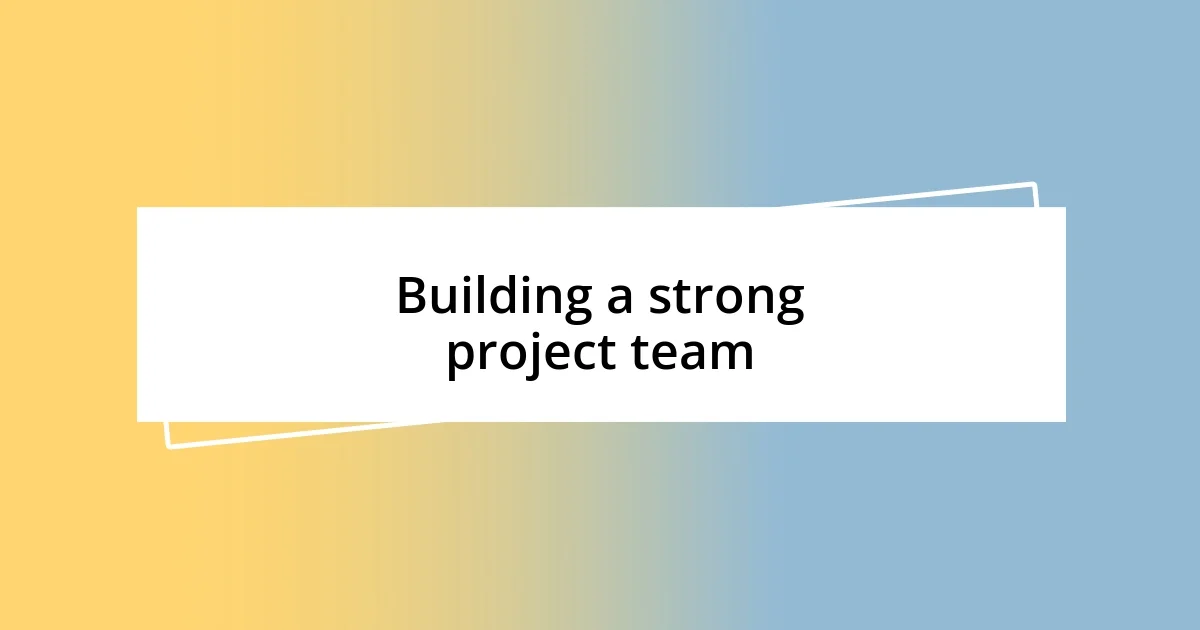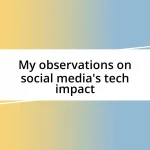Key takeaways:
- Clearly defined project objectives are essential for success, ensuring alignment and fostering motivation among team members.
- Effective scope definition, including stakeholder engagement and clear boundaries, helps prevent scope creep and enhances project focus.
- Regularly conducting post-project evaluations provides valuable insights, fosters team learning, and helps document lessons for future projects.

Understanding project objectives
Understanding project objectives is like setting the compass before a journey. I remember one project where we launched without clear objectives, and it felt like we were sailing without a map—we drifted for weeks before finally regrouping. It made me realize how vital it is to articulate what success looks like from the very beginning.
When I outline project objectives, I ask myself: What do we want to achieve? Is it growth, efficiency, or perhaps innovation? They’re more than just goals; they become the heartbeat of the project. I once facilitated a brainstorming session where the team passionately debated our objectives, and the energy in the room was electric. By involving everyone in this discussion, I found that we fostered a shared ownership that kept us motivated and aligned.
Clarity around objectives also paves the way for more effective communication. I often remind myself that objectives should be clear and specific—vague goals lead to vague efforts. It’s like trying to hit a target that’s constantly moving; it’s frustrating and counterproductive. So, I make it a point to revisit and refine our objectives throughout the project, ensuring we remain on track and engaged.

Defining project scope effectively
Defining the project scope is akin to putting the frame around a painting. I remember a time when a project spiraled out of control because my team didn’t take the time to clarify the scope upfront. It’s easy to get excited and dive headfirst into the work, but without a clear outline of what is included—and what isn’t—we wasted precious time chasing after every new idea that popped up. Missing that crucial step taught me to always define boundaries clearly, as they help everyone understand the “how” and “what” of the project right from the beginning.
In my experience, one important tool for effective scope definition is the use of a scope statement. This document outlines deliverables, timelines, and even boundaries of what’s excluded from the project, which I’ve found reduces the chances of scope creep. I vividly remember drafting the scope for a software development project, feeling the pressure of deadlines. By articulating not just what we would accomplish but also what we wouldn’t touch, the team felt a sense of relief and focus. It transformed our chaotic brainstorming sessions into more structured discussions about achievable targets.
Moreover, I always emphasize involving stakeholders when defining project scope. Their input is invaluable as it fills gaps I might overlook. A recent project taught me this when a key client encouraged us to reconsider one major feature we thought was essential. By integrating their feedback early on, we refined our scope and ended up delivering a product that felt like a collaborative triumph. I can’t stress enough how engaging all voices right from the start enriches the project and strengthens our commitment to delivering quality work.
| Scope Definition Method | Description |
|---|---|
| Scope Statement | A formal document that outlines deliverables, boundaries, and exclusions to prevent scope creep. |
| Stakeholder Engagement | Involving key stakeholders in discussions ensures all perspectives are considered, enhancing project alignment. |

Building a strong project team
Building a strong project team requires a thoughtful approach to selection and collaboration. From my experience, the right mix of skills and personalities can make or break a project. I recall one project where I handpicked team members not just for their expertise, but for their ability to communicate openly and adaptively. This intentional selection created a space where trust thrived. When team members feel valued and understood, they are more likely to contribute creatively and supportively.
To foster a solid team, I recommend focusing on the following aspects:
- Diverse Skill Sets: Ensure your team includes varied expertise to cover all essential areas.
- Open Communication: Create an environment where team members can share thoughts and ideas freely without fear of judgment.
- Shared Vision: Regularly revisit and discuss the project’s goals to keep everyone aligned and motivated.
- Team-Building Activities: Engage in exercises that build camaraderie and rapport outside of work tasks, strengthening relationships.
- Regular Check-Ins: Schedule consistent meetings to assess progress, share challenges, and celebrate achievements, reinforcing team cohesion.
It’s incredibly rewarding to see how a well-formed team can achieve more than the sum of its parts. For me, watching team dynamics evolve—from initial introductions to collaborative efforts—reminds me why investing in team building is so crucial. There’s nothing quite like the sense of accomplishment that comes when you realize that each member feels like an indispensable part of a greater mission.

Implementing agile methodologies
Implementing agile methodologies has truly transformed the way I approach tech projects. I remember when I first dived into Agile; it was like a breath of fresh air compared to the linear methods I had been using. The emphasis on iterative development allowed my team to pivot quickly in response to feedback, which was invaluable. I often find myself reflecting on a project where we released a minimum viable product (MVP) early on. It was a gamechanger, enabling us to gather real user input before fully committing to the final product.
One of the core tenets of Agile is the daily stand-up meetings. Initially, I was skeptical about their effectiveness. However, after a few weeks of consistent huddling, I witnessed a remarkable shift in our team dynamics. Each member seemed more engaged and invested in each other’s progress, and those quick touchpoints helped surface obstacles before they became roadblocks. Have you ever noticed how a simple conversation can reenergize a team? I’ve seen firsthand how maintaining open lines of communication can foster a culture of collaboration and keep everyone focused on the project’s goals.
Moreover, the flexibility of Agile methodologies makes it easier to navigate changing requirements. There was a time when a major stakeholder changed their mind about a feature halfway through the development process. Instead of a panic-induced scramble, we simply adjusted our backlog and reprioritized tasks. I’ve learned that this adaptability is one of Agile’s greatest strengths. It not only saves time but also encourages a mindset of continuous improvement. I’m curious, have you experienced a similar situation? I believe that handling changes gracefully can lead to innovative solutions that enhance the final product.

Managing project risks actively
Managing project risks actively is essential for steering a tech project toward success. I vividly remember a time when our team encountered a significant technical glitch just days before a major deliverable. Instead of panicking, we gathered for a quick brainstorming session to identify potential solutions. By approaching the problem collaboratively, we uncovered a workaround that not only addressed the current issue but also provided insights for future projects. How often do we let the unexpected derail us, rather than seeing it as an opportunity to innovate?
I find that regularly updating our risk assessment is crucial. Each time my team evaluates our potential challenges, we ensure that no critical issues slip through the cracks. For example, there’s been a project where I asked team members to share any concerns during our weekly meetings. This practice fostered a culture of risk awareness, and we caught a data security issue before it escalated. Isn’t it interesting how creating a space for open dialogue can turn perceived threats into manageable tasks?
Moreover, I’ve learned the value of contingency planning. There was a project where one of our key resources unexpectedly left, which could have thrown everything off balance. Fortunately, we had measures in place to redistribute responsibilities. I realized that having backup resources clearly defined not only eased my stress but also empowered the team. There’s something reassuring about knowing you have a safety net. Have you experienced the relief that comes from being prepared? Active risk management really is about anticipation and resilience, and I wouldn’t have it any other way.

Tracking project progress continuously
Tracking project progress continuously is vital for maintaining momentum and ensuring alignment with team goals. In my experience, using visual tools like Kanban boards has made a huge difference. I’m always amazed at how seeing tasks move from one stage to another can ignite a sense of accomplishment within the team. It really sparks motivation, don’t you think? Each transition feels like a small victory that collectively contributes to the project’s success.
Daily updates have also transformed the way I monitor progress. For instance, during a recent software development project, I started incorporating a brief end-of-day recap. This simple practice not only kept everyone accountable but also allowed us to recognize and celebrate the day’s achievements. I’ve noticed that when we acknowledge our wins, no matter how small, it fosters a positive atmosphere. Have you ever thought about how recognizing even minor victories can elevate team morale?
Additionally, using tools for real-time tracking, like project management software, has been indispensable. I remember a project where we set specific milestones in our tool and mapped out timelines. This approach didn’t just help in monitoring progress but also facilitated open discussions about any bottlenecks. It’s fascinating to witness how transparency in tracking creates a shared sense of ownership. Don’t you think that feeling of shared responsibility can propel a project forward?

Conducting post-project evaluations
Conducting post-project evaluations is a crucial step that often gets overlooked. I remember leading a project where we didn’t take the time to debrief afterward, and it left me wondering what we could have learned from it. In subsequent projects, I made it a point to schedule a calm evaluation session with the team, discussing what went well and what didn’t. Isn’t it interesting how those reflections can spark insights for our future endeavors?
One particular evaluation stands out to me. After a challenging rollout of a new system, we gathered for a roundtable discussion. Encouraging everyone to share their thoughts created an atmosphere of openness. Some team members revealed frustrations about communication lapses, while others highlighted opportunities we missed. It was in those candid moments that I truly appreciated the collective intelligence of my team. Have you ever considered how much richer project outcomes could be when we evaluate them together?
I’ve also learned the importance of documenting these evaluations for reference in future projects. In one instance, we compiled our findings into a report that became a go-to resource for subsequent teams. I’ve found that having tangible takeaways solidifies lessons learned and ensures they’re not forgotten. Isn’t it reassuring to think that each completed project can serve as a stepping stone for the next?












